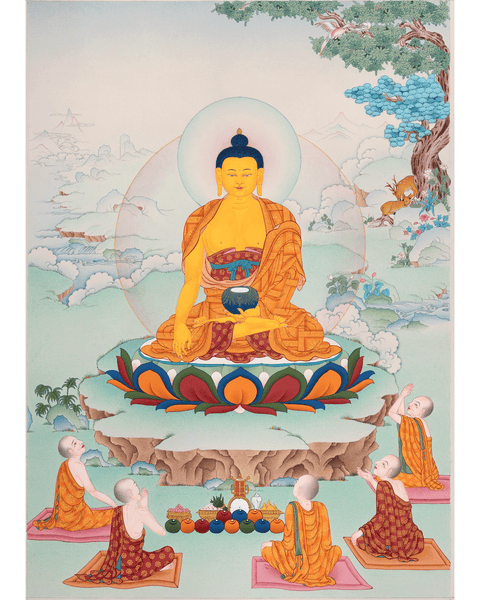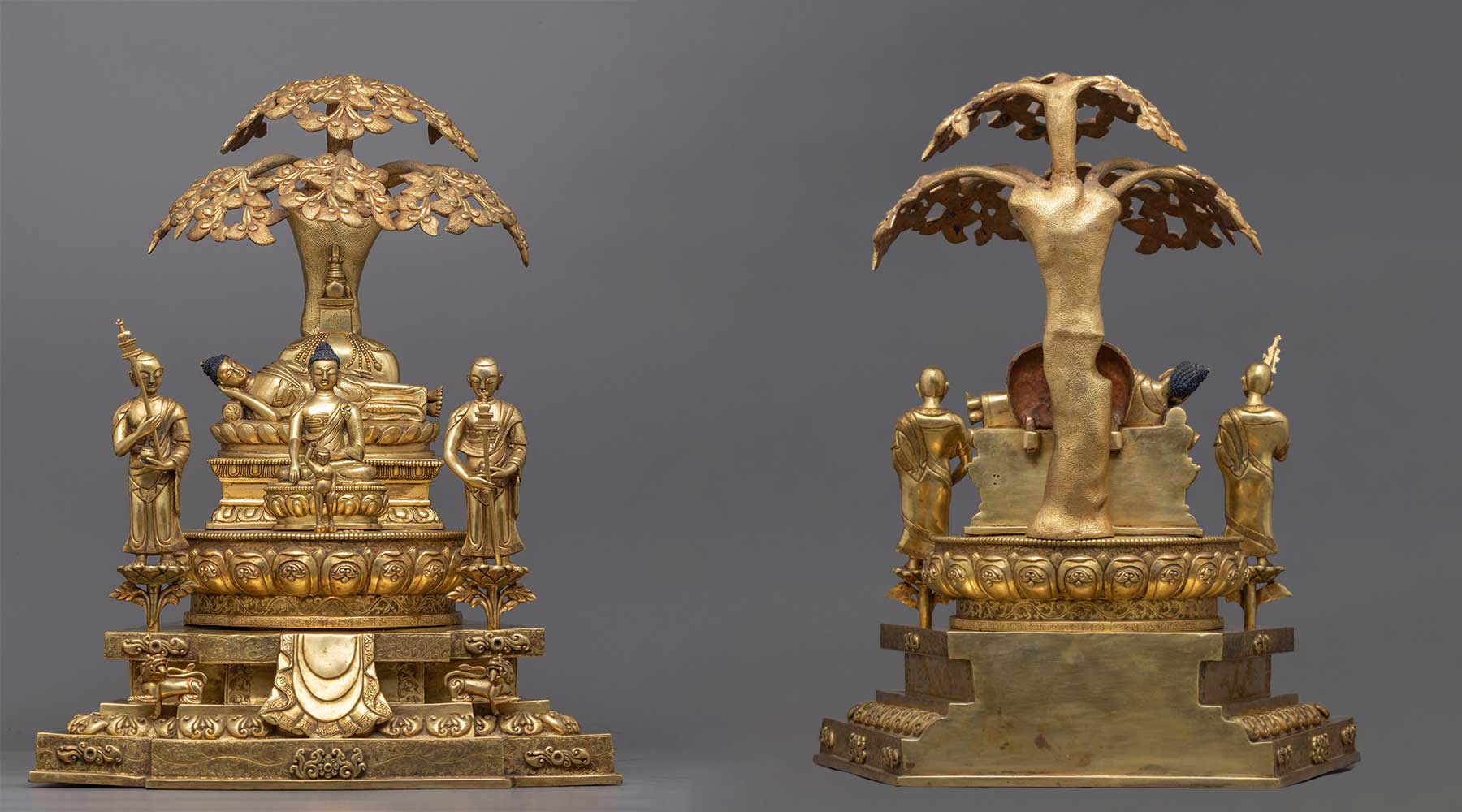Rahula,Son of Buddha: Exploring the Legacy of Enlightenment
In Buddhist traditions, Rāhula has a unique position. He is frequently recognized as the historical son of Siddhartha Gautama, also known as the Historical Buddha, and his wife Yaśodharā. His life narrative sheds light on several Buddhist teachings, including detachment, living as a monk, and pursuing nirvana.
Key Takeaways:
- Rāhula is a significant figure in Buddhism, symbolizing the potential for spiritual growth and the renunciation required in monastic life.
- He was the only child of Siddhartha Gautama (Buddha) and was born on the same day Siddhartha left his palace to seek enlightenment.
- Rāhula joined the monastic community at a young age, demonstrating the importance of spiritual training in Buddhism.
- His life is a profound example of the teachings on detachment and renunciation.
Early Life and Birth
The birth of Rāhula has a vital symbolic significance and a close relationship to the core ideas of Buddhism, and it is entwined with essential moments in Buddhist history.
The Significance of His Name

King Śuddhodana, Rāhula's grandfather, called him Rāhula, which means "fetter" or "bond." The king's conflicted emotions at his grandson's birth, occurring at the same time as his son's departure, may have contributed to the significance of this name, symbolizing the obligations and bonds accompanying parenthood. The term represents the worldly attachments that practitioners of Buddhism are taught to let go of.
Birth and Royal Life
On the very night when his father, Siddhartha Gautama, departed the palace in pursuit of enlightenment, Rāhula was born. His early years were spent amid the opulence of Kapilavastu's royal palace, where he was raised by his grandpa, King Śuddhodana and his mother, Yaśodharā. Even with the perks of royalty, his life was meant to follow his father's path of spiritual exploration.
Entry into Monastic Life
A pivotal point in Rāhula's life is his transformation from royal heir to novice monk, which serves as an example of the Buddhist principles of renunciation and the search for spiritual truth.
- Joining the Buddha
When Siddhartha became the Buddha and returned to his hometown Rāhula's mother brought him to him. She instructed him to petition his father for his inheritance.
In response, the Buddha requested his pupil Śāriputra to ordain Rāhula, concluding that a spiritual legacy was the finest gift he could provide. The Buddha's dedication to his spiritual purpose and his want for his son to follow in his footsteps were both amply demonstrated by this deed.
- Early Teachings and Ordination
As one of the earliest novices in the Buddhist order, Rāhula is frequently used as an illustration of the sincerity and mindfulness teachings of the Buddha.
The Buddha notably taught him the value of considering one's deeds in the same way a mirror reflects one's looks. These lessons, addressed to a youthful Rāhula, are documented in several suttas and stress the importance of moral behavior and self-awareness.
Life as a Monk

Rāhula embodied the lessons he was taught and was an example of commitment and seriousness throughout his monastic life.
- Teachings from the Buddha
The Buddha imparted significant knowledge about Rāhula and wrote several sutras, including the Rāhulovāda Sutta, which promotes monastic discipline, the development of mindfulness, and insight. These teachings influenced his spiritual growth and provided essential guidance for all the monks in the community.
- Renunciation and Enlightenment
Rāhula was a well-known monk who followed strict austerities and was renowned for his sincerity and commitment to the monastic life. At some point, he attained Arhatship, representing his spiritual development's pinnacle. His ascetic life is a model of the transformational potential of the monastic path and the teachings of the Buddha.
Philosophical and Spiritual Contributions
Through his life and teachings, Rāhula contributed substantially to Buddhist philosophy by highlighting essential Buddhist ideas.
- Teachings on Detachment
He stressed the value of renunciation and detachment via his teachings and personal life. His life exemplifies the Buddha's teachings that one must give up material attachments to attain spiritual freedom. Understanding his function and the broader ramifications of his teachings among the Buddhist community depends on this subject.
- Influence on Buddhist Monasticism
His early ordination and spiritual growth significantly influenced the monastic community's policy of admitting young novices. His life story exemplifies how the monastic path in Buddhism may alter people, impacting successive generations of monks.
Symbolism and Iconograpy
Rāhula, the son of Buddha, is not as frequently shown in Buddhist iconography as other notable individuals like the Buddha or his most eminent followers.
However, when he is shown, his iconography has specific components that express his standing and spiritual importance in the Buddhist canon. An extensive examination of his physical characteristics and iconographic depictions is provided below:
|
Attribute/Element |
Description |
Significance |
|
Youthful Appearance |
Depicted as a young boy or youth. |
Symbolizes purity and potential for spiritual growth, reflecting the virtue of early renunciation. |
|
Monastic Robes |
Wears simple, ochre-colored monastic robes. |
Signifies renunciation of worldly life and royalty, highlighting a life dedicated to spiritual practice. |
|
Shaved Head |
Reflects monastic practice, shown with a shaved head. |
Represents detachment from vanity and ego, embodying humility and spiritual discipline. |
|
Serene Expression |
Often shown with a serene and composed face. |
Indicates inner peace and spiritual maturity, a result of deep meditation and enlightenment practices. |
|
Holding Alms Bowl |
May hold an alms bowl. |
Symbolizes humility and the monastic practice of relying on the lay community for sustenance. |
|
Lotus Position |
Possibly depicted sitting in the lotus position (padmasana). |
A symbol of purity and meditation, representing the ability to rise above the material conditions like a lotus. |
|
Near the Buddha |
In group depictions, positioned close to the Buddha. |
Emphasizes his close relationship with the Buddha and his importance among the Buddha’s disciples. |
|
Symbols of Learning |
Associated with scrolls or books in some depictions. |
Highlights his role in learning and transmitting the Buddha’s teachings, underscoring his wisdom and scholarship. |
Mantra of Rahula
Unlike scriptures from the Theravada or early Mahayana schools, the ancient texts of Buddhism do not directly link Rāhula, the son of Buddha, to a single mantra.
Nonetheless, Rāhula assumes a distinct significance in Vajrayana Buddhism, where the use of mantras is more common and is connected to an astrological and protective function rather than merely being the actual son of the Buddha.
"OM RAHULA VIDHUMA HUM PHAT"
- OM: This sacred sound is frequently used to start chants that invoke the essence of ultimate reality or awareness.
- Rahula: Using Rāhula's name directly, this chant alludes to his might and protecting attributes.
- VIDHUMA: This word is frequently linked to astrological and celestial aspects; it may allude to Rāhula's function in mitigating unfavorable astrological impacts.
- HUM: A seed syllable used to eliminate negativity and delusions, signifying the mind of enlightenment.
- PHAT is a syllable frequently employed in Tantric activities to represent a powerful cutting through illusions and barriers.
Benefits of the Rāhula Mantra:
The chanting of this mantra is believed to provide several spiritual and worldly benefits, particularly in the Vajrayana tradition:
- Protection Against Harmful Forces: By invoking Rāhula's protecting powers, the practitioner is believed to be shielded from harm and harmful influences.
- Overcoming Obstacles: It helps practitioners stay on track toward their objectives by removing barriers that stand in the way of their spiritual and personal development.
- Neutralizing Negative Astrological Influences: Since he is linked to managing and alleviating unfavorable planetary alignments, this mantra can be employed to offset unfavorable astrological patterns.
- Improving Spiritual Development: It is thought that calling upon his powers gives the practitioner the fortitude to follow moral principles and spiritual rituals more assiduously.
The Tale of Rāhula and the Water Bowl
Once, as a young novice in the monastic order, Rāhula lied to conceal a minor transgression. Even though the falsehood seemed little, the Buddha used it as a chance to deliver a profound lesson on the value of truthfulness, which is central to the Buddhist path.
The Teaching Begins

Rāhula was called to carry a bowl of water by the Buddha one day after he had made the small falsehood. He did what he said and brought the dish full to overflowing.
Subsequently, the Buddha requested Rāhula to discard a small amount of the water and inquired about what remained. He answered, pointing out that plenty of water remained. Until very little water was left, the Buddha asked his son to discard additional water several times.
The Lesson Unfolds
Ultimately, the Buddha instructed Rāhula to discard the remaining water and requested that he examine the bowl and report any observations he made. Now, Rāhula saw that the dish was empty.
The Buddha said that this empty bowl represented someone fond of lying. He explained to Rāhula that a liar is devoid of moral character, just as an empty dish is devoid of water.
The Mirror of Truth
Subsequently, Rāhula was instructed by the Buddha to fill the bowl again. The Buddha invited him to view his reflection in the water. In the still water, Rāhula could see his picture.
"Truthfulness reflects your deeper self, just as you can see your reflection in clear water," the Buddha said. Lying clouds the truth and prevents you from realizing who you are. It's like throwing out water.
The Symbolic Gesture
The Buddha then removed the bowl and tipped it over, spilling the contents. He clarified that a liar could not hold moral goodness or the confidence of others, just as an overturned bowl could not have anything. The Buddha emphasized that without sincerity, no virtue could grow spiritually and that truthfulness was the basis of all virtues.
The Enduring Message
That day, Rāhula learned a profound yet evident lesson. The water and the bowl are two straightforward yet potent symbols that the Buddha used to convey lessons about the adverse effects of dishonesty and the need for purity in spiritual practice.
This tale emphasizes the need for honesty and integrity for anybody on the spiritual path—especially for those who have given up on worldly life in pursuit of enlightenment—and has been passed down through the ages as a fundamental teaching in Buddhism.
This story not only depicts his experience as a follower who received direct instruction from the Buddha, but it also functions as a teaching aid by providing a striking and unforgettable example of core Buddhist ideals. It is still prevalent in Buddhist groups and is frequently taught to young initiates as they begin their spiritual journey.
The life tale of Rāhula, from royal ancestry to famous monk, is a potent story of Buddhist spiritual development. His journey serves as a powerful reminder of the fundamental Buddhist teachings of detachment, mindfulness, and the goal of enlightenment. As such, Buddhists worldwide can draw inspiration and guidance from his experience.




